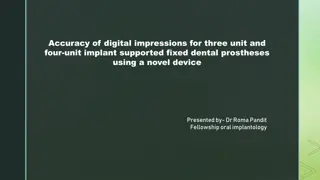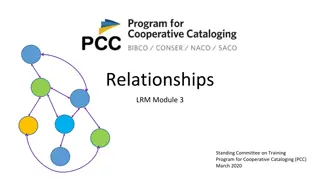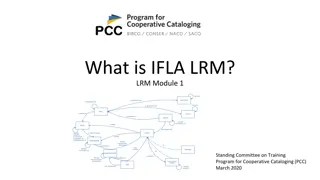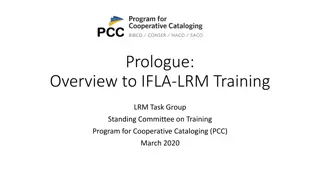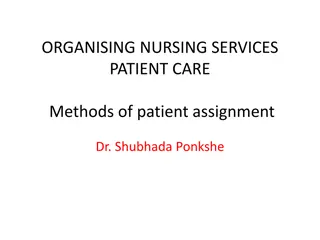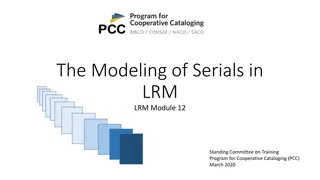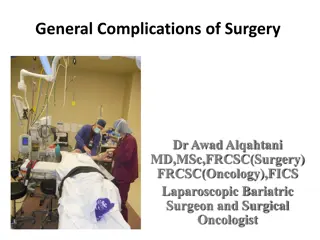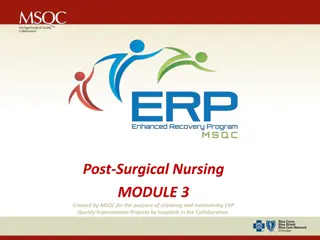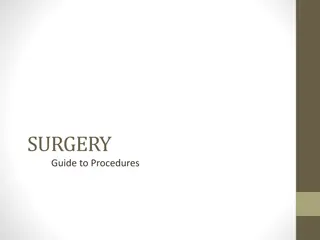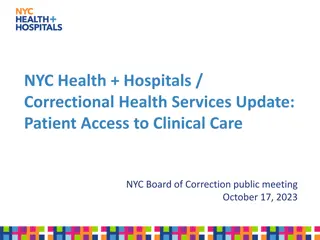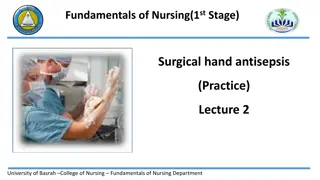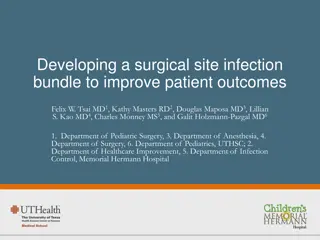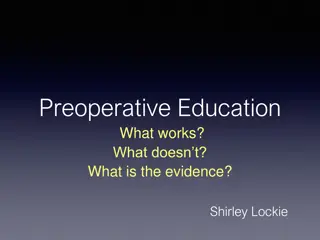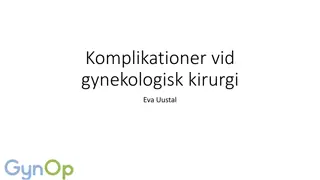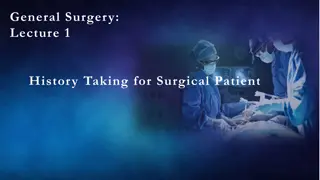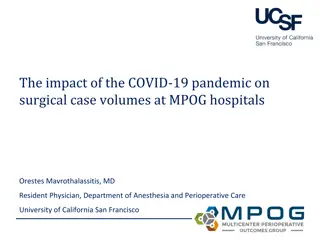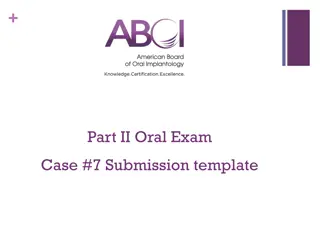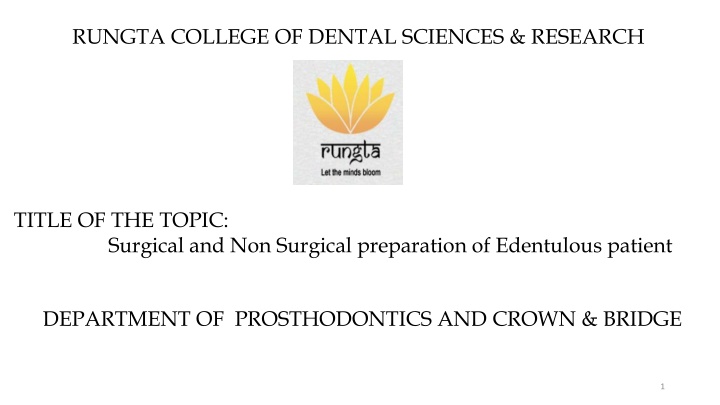
Surgical and Non-Surgical Preparation of Edentulous Patient - Prosthodontics Insights
Explore the comprehensive guide on surgical and non-surgical preparation for edentulous patients in the field of prosthodontics and crown & bridge procedures. Delve into the core areas, types of surgeries, management strategies, and key takeaways highlighted in the presentation.
Download Presentation

Please find below an Image/Link to download the presentation.
The content on the website is provided AS IS for your information and personal use only. It may not be sold, licensed, or shared on other websites without obtaining consent from the author. If you encounter any issues during the download, it is possible that the publisher has removed the file from their server.
You are allowed to download the files provided on this website for personal or commercial use, subject to the condition that they are used lawfully. All files are the property of their respective owners.
The content on the website is provided AS IS for your information and personal use only. It may not be sold, licensed, or shared on other websites without obtaining consent from the author.
E N D
Presentation Transcript
RUNGTA COLLEGE OF DENTAL SCIENCES & RESEARCH TITLE OF THE TOPIC: Surgical and Non Surgical preparation of Edentulous patient DEPARTMENT OF PROSTHODONTICS AND CROWN & BRIDGE 1
Specific learning Objectives At the end of this presentation the learner is expected to know ; Core areas* Domain ** Category # Introduction Cognitive Must know Definition Cognitive Must know Types of surgeries Cognitive Must know Management Cognitive Must know Take home message Cognitive Must know References Affective Desired to Know 2
Table of Content Introduction Definition Types of surgeries Management Take home message References 3
Pre-prosthetic surgery encompass all surgical procedures relative to preparing the tissues to support the dentures, and in general contributing to the functional and esthetic success of the dentures.
Types of Surgery: I. Basic preprosthetic surgical procedures A. Removal of teeth - Erupted - Unerupted - Partially erupted - Root stumps - Cysts
B. Bony recontouring of alveolar ridges Single alveoloplasty associated with removal of multiple teeth Alveoloplasty Maxillary tuberosity reduction Buccal exostosis Lateral palatal exostosis Genial tubercle reduction
C. Tori Removal: Maxillary tori Mandibular tori D. Soft tissues procedures: Labial frenectomy Lingual frenectomy Inflammatory papillary hyperplasia of the palate Unsupported hypermobile tissues Epote fissuration
II. Advanced Pre-prosthetic surgery: Surgery for ridge extension Vestibuloplasty Surgery for ridge augmentation A. Retained Dentition Erupted Unerupted Partially erupted Root stumps Cysts.
B.Bony recontouring of alveolar ridges alveoloplasty: It is the surgical contouring of the alveolar process. Conservative alveoloplasty is required after the extraction of the single tooth, if prominent areas of bone are left behind. Sharp bony spicuks may cause pressure zones under the Dentures. Maxillary Tuberosity Reduction: Lateral or vertical excess of the maxillary tuberosity area may be a result of excess bone, soft tissues or both.
Technique -Local anaesthesia -Crestal incision extending up to the posterior aspect of the tuberosity area -Full thickness mucoperiosteal flap is reflected in buccal and palatal directions -Bone is removed using a side cutting rongeur or rotary instrument.
KNIFE EDGE RIDGE -Mid crestal incision -Flap is reflected -Rongeurs, bone files or rotary burs and employed for smoothening the alveolar process. -Wound is irrigated -Flap is replaced back -Sutured.
-Tori are hard bony growth Torus palatinus should be removed if one or more conditions exist -They are large and interfere with speech -Extend posteriorly affect PPSA -Denture stability, because of fulcrum -Small tori can be retained and the denture relieved to prevent the fulcrum effect.
Soft Tissue Abnormalities Prominent Labial Frenum: A high frenal attachment of the labial frenum can cause instability of the denture and disturb the peripheral seal of the denture. With No.11 B.P. blade, the labial frenum is excised by cutting around the outside surfaces of the two hemostats.
Lingual Frenectomy Tongue is grasped with tongue holding forceps
Prominent Buccal Frenum! Papillary Hyperplasia: Develops in the palatal vault as multiple papillary projections of the epitheium in response to local irritation, poor oral hygiene, and low- grade infections such monilia
Epuli Fissuratum: Result from chronic irritation of a poorly fitting denture flange on the sulcular epithelium. Lesion appears from small single folds to multiple folds or redundant soft tissue. Rx: Tissue rest Shortening of the flange Surgical excision of fibrous tissue.
Ridge extension surgery: VESTIBULOPLASTY -Designed to restore alveolar ridge hight. Indications: Good health Maintenance PE s Co-operation Contraindications: Neurotic Psychotic Depressed Medically compromised
Denture bearing area is increased by shifting the soft tissue attachments deeper. More commonly required in mandible than in maxilla Labial Vestibuloplasty Lingual vestibuloplasty Incision: Depth of the sulcus disect supra periosteally to separate the labial and alveolar tissues.
Ridge Augmentation: Involve replacement of bone autogenous bone from the 6th or 9th rib or iliac crest used in solid pieces than chips. Alloplastic - HA crystals acrylic Procedures involve: -Direct augmentation of the superior border mandible -Augmentation of the inf. Border of mandible -Augmentation of maxilla -Interposition bone grafts.
Summary Many conditions exist in dentistry which may interfere during the construction of the dentures. Some of these conditions can be corrected by surgery which can improve patients function , comfort, aesthetics and psychology . 26
TAKE HOME MESSEGE Knowledge of anomalies are essential , Selection of corrective procedure is utmost importance in preserving and maintain remaining structure after fabrication of the prosthesis 27
REFERENCES Boucher s Prosthodontic Treatment For Edentulous Patients, 12th Edition Winkler s Essentials Of Complete Denture Prosthdontics, 2nd Edition Zarb & Bolender s Prosthodontic Treatment For Edentulous Patients, 13th Edition Rahn & Heartwell s Textbook Of Complete Denture, 5th Edition. 28
THANK YOU 29



